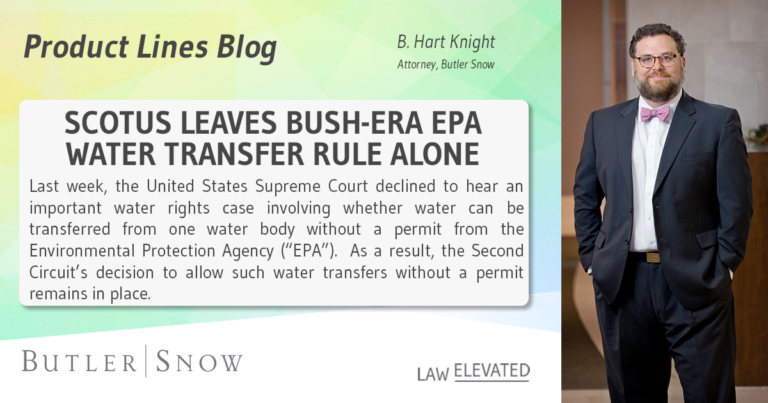Last week, the United States Supreme Court declined to hear an important water rights case involving whether water can be transferred from one water body without a permit from the Environmental Protection Agency (“EPA”). As a result, the Second Circuit’s decision to allow such water transfers without a permit remains in place.
EPA’s 2008 “Water Transfers Rule” formalized the Agency’s historic practice of taking a laissez-faire approach to transfers of water between water bodies largely for providing drinking water to the public, irrigation, and power generation. The Rule defines a water transfer as an activity that conveys or connects waters of the United States without subjecting the transferred water to intervening industrial, municipal, or commercial use. Per the Rule, the EPA did not require transferors to obtain National Pollution Discharge Elimination Permits prior to such transfers, even if the water being transferred contained pollutants.
Thereafter, several states, tribal governments, and environmental groups filed suit against EPA, challenging the Water Transfers Rule. In 2014, the District Court in New York (ruling on a number of related, consolidated cases) rejected the EPA’s application of its own Water Transfers Rule, declaring the Rule an unreasonable interpretation of the Clean Water Act. The Court opined that EPA acted in an arbitrary and capricious manner when allowing blanket exemptions for the transfers. The Court vacated the Rule and remanded it to EPA for further assessment. Environmental organizations hailed the ruling as a victory over “dirty water transfers.” But supporters of farming and irrigation districts have decried the ruling as a “direct assault on irrigation districts and water wholesalers.”
As expected, Defendants appealed. In early 2017, the United States Court of Appeals for the Second Circuit, in a 2-1 split, reinstated EPA’s Water Transfers Rule, providing a victory for water suppliers, power generators, farmers, and cities and municipalities that rely on transferred water. Applying the Chevron deference analysis, the Court concluded that EPA’s interpretation of the Clean Water Act is “reasonable and neither arbitrary nor capricious.” Once again the matter decision was appealed.
On February 27, the Supreme Court declined to hear the appeal, leaving in place the Second Circuit’s determination that such water transfers do not require a permit from the EPA. Should the Supreme Court have reversed the Second Circuit’s ruling, several water districts contend that it would have cost over $4 billion to treat the most significant water transfers in the Western United States and that obtaining and complying with the permits could cost a single water supplier hundreds of millions of dollars. The Supreme Court’s rejection of this appeal ends a long line of litigation on this issue….for now.

